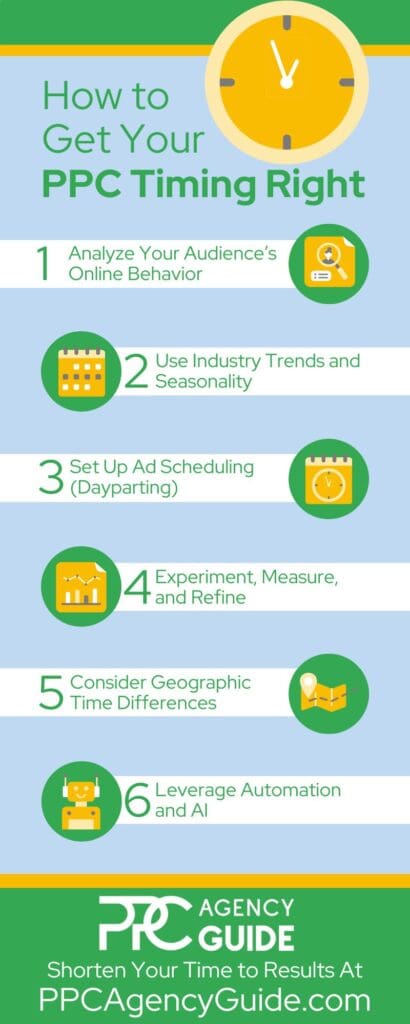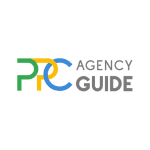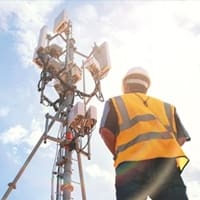
Picture a local restaurant that’s running pay-per-click (PPC) ads to promote lunch specials. They’ve done their homework and are leveraging a variety of tactics, including percent-off offers, mouthwatering images, and reviews from happy customers. These ads are irresistible and guaranteed to create a line out the door. They’ve even gone the extra mile to target people in close proximity to the restaurant, which sits in a commercial park where hungry businesspeople are always in need of good food with fast service. There’s just one problem: the ads are running on nights and weekends. Their PPC campaign timing is off.
This may seem like an obvious issue most businesses wouldn’t make, but the reality is that businesses often get the timing wrong. It just happens in less obvious ways.
In this guide, we’ll walk you through what you stand to gain by reviewing your campaigns for time disconnects and how to make sure you get your PPC campaign timing right.
PPC Campaign Timing is Crucial
The importance of timing in PPC campaigns cannot be overstated. Timing directly impacts how effective your PPC ads are and how efficiently your budget is spent. Launching your campaigns at the right moment can boost visibility, lower your costs, and increase conversions. Let’s take a look at the mechanisms behind this.
Consumer Behavior Changes Based on Time
People’s online behavior naturally changes based on daily routines, days of the week, and even seasons. When you align your PPC campaigns with these behaviors, you reach potential customers exactly when they’re most likely to engage.
- Daily Patterns: Searches peak at different times depending on your audience. For instance, professionals often look for business solutions early in the workday, while personal purchases might spike during lunch breaks or evenings.
- Weekly Cycles: Some industries, like hospitality or entertainment, see increased searches leading into the weekend. B2B companies often experience higher activity early in the workweek.
- Seasonal Demand: Many products or services have predictable seasonal spikes. For example, tax preparation services typically see searches rise significantly from January through April, while home improvement businesses see increased interest during spring months.
Timing Impacts the Efficiency of Your Campaigns
Launching ads at the best times means less waste in your advertising spend. When ads run during peak periods of interest, you pay for clicks that genuinely matter.
- Lower Costs per Click: Effective timing helps you avoid bidding wars during highly competitive but less profitable times. By targeting windows of high relevance to your audience, you can often pay lower rates per click while maintaining or even improving results.
- Better Conversion Rates: When your ads appear exactly as potential customers actively look for your product or service, you naturally generate higher-quality clicks and more conversions.
How to Get Your Timing for PPC Ads Right
To ensure your PPC ads appear exactly when your audience is most responsive, follow the steps below.
1. Analyze Your Audience’s Online Behavior
Your starting point is understanding when your potential customers search for your products or services.
- Review Historical Data: Look at past campaigns or analytics tools like Google Analytics. Check what days of the week and hours of the day visitors arrive on your site most frequently.
- Identify Patterns: Notice peaks and valleys in traffic. For example, do you see spikes during lunch hours or evenings? Are weekdays stronger than weekends?
2. Use Industry Trends and Seasonality to Your Advantage
Certain times of the year or month naturally generate more interest in specific products or services.
- Map Out Seasonal Demand: List your business’s busy periods. For example, accounting firms experience peaks from January to April to coincide with tax season.
- Align Campaigns with Trends: Plan your campaigns around these seasonal opportunities to maximize impact and minimize wasteful spending.

3. Set Up Ad Scheduling (Dayparting)
Ad scheduling is a built-in PPC feature allowing you to specify exactly when your ads run.
- Choose the Right Days: Select the days your data shows have the strongest user engagement.
- Select Optimal Hours: Narrow it down further, choosing specific time blocks that yield the best results.
- Adjust Bids Strategically: Increase your bids during high-performing times and lower them when engagement typically dips.
4. Experiment, Measure, and Refine
Maximizing ROI with PPC campaign timing requires ongoing optimization. Once you’re up and running, keep moving the needle to improve your results.
- Run Controlled Tests: For example, experiment by slightly adjusting start and stop times or varying bid amounts during specific hours.
- Track Key Metrics: Monitor click-through rates, cost per click, conversion rates, and overall return on investment to evaluate effectiveness.
- Make Incremental Adjustments: Use what you learn from testing to continuously refine your schedule for improved results.
5. Consider Geographic Time Differences
If your audience covers multiple time zones, be sure to adjust your timing to align with them.
- Segment Campaigns by Region: Set different ad schedules tailored to local business hours or peak engagement periods.
- Monitor Regional Performance: Regularly check regional campaign data to confirm effectiveness, adjusting as needed.
6. Leverage Automation and AI
Advanced PPC platforms, such as Google Ads, offer automated bidding and scheduling.
- Activate Smart Bidding Strategies: Utilize features like Google’s Smart Bidding to automatically adjust bids based on real-time engagement data.
- Combine Human Insight and AI: Regularly review automated performance to ensure alignment with business goals and adjust manually if necessary.
Common PPC Timing Mistakes and How to Avoid Them
Even seasoned marketers occasionally fall into timing traps that reduce campaign effectiveness. Understanding these pitfalls is the key to improving your results.
Set and Forget Mentality
Avoiding common PPC timing mistakes often starts with moving past the habit of launching campaigns and leaving them unchanged. PPC is dynamic, and customer behavior changes regularly. Schedule routine checks and make necessary adjustments based on fresh data.
Misalignment with Customer Needs
One common issue is running campaigns without aligning PPC campaigns with consumer demand. Ads appearing at times when customers won’t act on them lead to wasted budgets. Regularly analyze your audience’s online activity and tailor ad schedules accordingly.

Ignoring External Events
Not accounting for major events or trends can impact campaign outcomes. For example, ignoring major holidays or events relevant to your audience could cause missed opportunities. Include these events in your planning calendar from the start.
Additional Tips for PPC Campaign Scheduling
Beyond avoiding common pitfalls, a few advanced strategies help in further optimizing PPC timing and maximizing returns.
Use Advanced Ad Scheduling Tactics
- Use Search Data for Ad Scheduling: PPC campaigns can target specific hours or days when your audience actively searches, maximizing your chance of reaching engaged customers.
- Know When it’s Important to Have Ad Visibility: PPC ads appearing in peak viewing positions are more likely to generate clicks and conversions, so use bid adjustments to gain top placements during key periods.
Monitor PPC Ad Trends
- Stay Tuned into Your Industry: Keep a close eye on PPC ad trends within your industry and adjust timing proactively rather than reactively.
- Compare Against Benchmarks: Regularly review industry benchmarks and competitor activities to identify emerging patterns.
Apply Bidding and Budgeting Strategies
- Implement Real-Time Bidding: Real-time bidding for PPC campaigns can be highly effective in competitive markets. Real-time PPC bidding allows you to dynamically adjust your bids based on live data, ensuring your ads appear when competition is manageable and conversions are likely.
- Maximize Your Budget: Timing PPC right can make your spending more impactful. Allocate more budget to periods with higher conversion likelihood, while scaling back spending during quieter times.
Leverage Seasonal Opportunities
- Develop Seasonal PPC Strategies: PPC for seasonal trends can significantly increase your campaign’s performance. Implement seasonal PPC timing by setting budgets and bids according to fluctuations in demand. For example, retail businesses typically increase budgets leading up to Black Friday or Cyber Monday.
- Make Seasonal Budget Adjustments: Seasonal budget adjustments for PPC help maintain efficiency throughout the year. Increasing budgets during PPC for peak seasons ensures you capture maximum market share, while reducing spend during quieter periods controls costs effectively.
PPC Timing Strategies for Unique Situations
Certain industries and scenarios require specialized approaches to campaign timing. We’ll take a look at some of these situations below.
Timing Strategies for Service Industries
It’s common for service-oriented businesses to experience spikes at particular times. For instance, home improvement services typically see higher search volumes during weekends and evenings. Develop timing strategies for service industries by closely analyzing when potential clients actively seek your solutions.
PPC Timing for Urgent Services
Urgent services, like emergency plumbing or roadside assistance, require precise scheduling. Optimize PPC for urgent services by increasing visibility and bids during times when emergencies commonly occur, such as evenings, nights, and weekends. Effective PPC timing for urgent services means capturing demand exactly when customers urgently need your help.
Regional PPC Timing Considerations
Regional timing nuances in PPC campaigns should be incorporated if your audience spans multiple locations. Consider different time zones and local routines. Adjust regional PPC timing accordingly so your ads reach people during optimal local engagement periods.
Understanding Cultural PPC Trends
Cultural PPC trends impact when and how people engage with ads. Holidays, cultural festivals, or local events significantly alter user behavior. Tailoring your timing to these events improves ad effectiveness and resonates more deeply with your audience.
Industry-Specific PPC Timing Strategies
Certain industries have very distinct timing patterns. Restaurants, for instance, benefit from lunch and dinner-hour peaks, while healthcare providers often see increased searches on weekdays during business hours. Build your industry PPC schedules by examining typical customer routines and adapting industry-specific PPC timing strategies accordingly.
Responding to Unexpected Events
Sometimes, external events rapidly change search patterns. A weather event, sudden market shifts, or breaking news can instantly alter consumer behavior. Have a contingency plan in place to quickly adapt your PPC scheduling and messaging to capitalize on these unexpected shifts.
Get Help Ensuring Your PPC Campaign Timing is Right
Getting timing in PPC ads right can be difficult, but it’s well worth the effort. If you’re not getting results from your campaigns or aren’t sure when to run ads, bringing in a pro can save time and money. We help shorten the time to results by matching businesses with vetted agencies that understand the best PPC timing for various situations and other tactics to ensure you’re maximizing ROI. To be matched with a suitable agency, request a free consultation.
FAQs on PPC Campaign Timing
Where do I get historical data for PPC optimization?
Data analysis for PPC scheduling typically involves tools like Google Ads, Google Analytics, and Microsoft Advertising. These platforms offer detailed historical data on clicks, impressions, and conversions. You can use this information to pinpoint the best-performing days and times, guiding your campaign scheduling decisions.
What are the best PPC scheduling tools?
Leading PPC timing tools include Google Ads' built-in ad scheduler, Microsoft Advertising scheduler, SEMrush, and WordStream. These tools help you precisely control when your ads run, adjust bids automatically, and analyze timing data to consistently optimize campaign performance.
What’s the best timing for ad engagement?
How timing affects PPC ad engagement varies by industry and audience habits. Generally, PPC ad engagement is highest during daytime business hours for professional services, early evening hours for retail consumers, and weekends for leisure and entertainment. Continuous testing helps identify optimal timing for your specific market.
How does seasonal timing impact PPC campaigns?
Seasonal trends significantly affect PPC performance. Businesses see substantial spikes during specific times, such as holidays or seasonal shifts. By aligning PPC ads to these peaks, adjusting bids, and budgeting accordingly, you can improve ad relevance, conversion rates, and overall return on investment.
Should I run PPC ads continuously or schedule specific periods?
Continuous campaigns build consistent visibility but may waste budget during off-peak times. Scheduled ads maximize your budget by displaying ads only when your audience actively searches. A blended approach often works best: continuous visibility during core business hours, enhanced bids during peak times, and reduced activity in slower periods.
How often should I adjust my PPC ad scheduling?
Regular adjustments based on performance data yield the best results. Review your PPC scheduling every four to six weeks, focusing on performance metrics like clicks, conversions, and return on ad spend. Frequent fine-tuning ensures your ads consistently reach audiences at optimal times.
Does geographic location affect PPC timing?
Absolutely. Geographic locations, especially multiple time zones, significantly influence PPC timing. To maximize results, set distinct scheduling and bids for each region. Tailoring ad visibility to local search behavior ensures your ads appear precisely when local audiences are most receptive.


















